 W
WA solutional cave or karst cave is a cave usually formed in the soluble rock limestone. It is the most frequently occurring type of cave. It can also form in other rocks, including chalk, dolomite, marble, salt beds, and gypsum.
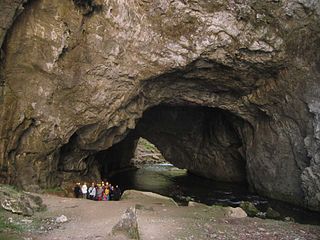 W
WA ponor is a natural opening where surface water enters into underground passages; they may be found in karst landscapes where the geology and the geomorphology is typically dominated by porous limestone rock.
 W
WAggtelek Karst is a karst area in northern Hungary.
 W
WThe Benxi Water Caves is a partially submerged cavern system containing a forest of stalactites and stalagmites, located 26 kilometres (16 mi) east of Benxi, Liaoning Province, People's Republic of China. It was made a national park on January 10, 1994, and is open to the public all year round. It was designated an "AAAAA"-class tourist attraction by CNTA in 2015.
 W
WThe Blauhöhle is the largest cave system in the Swabian Alps in southern Germany. The Blauhöhle presumably originated in a time when the Danube still flowed through the Blau valley. Since the shifting of the Danube, several small rivers, the Schmiech, the Ach, and the Blau, have flowed through this valley. The cave system begins about 21 meters under water at the base of the Blautopf. It continues west and northwest, rising and falling several times until after a horizontal distance of about 1,200 metres (3,900 ft) it comes above the level of ground water and opens into the second big air-filled chamber. The maximum depth of the cave under water is 42 metres (138 ft).
 W
WThe Borgio Verezzi Caves, also named Valdemino, are a karst cave system located in the municipality of Borgio Verezzi, in the province of Savona, Liguria. They are a show cave.
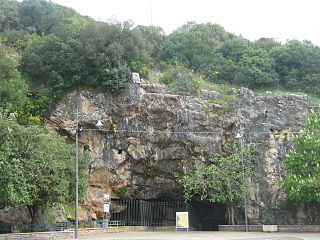 W
WThe Castelcivita Caves are a karst cave system located in the municipality of Castelcivita, in the province of Salerno, Campania, southern Italy.
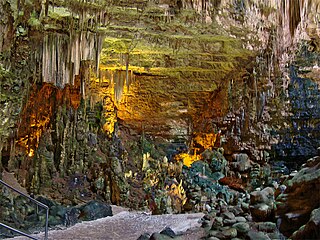 W
WThe Castellana Caves are a karst cave system located in the municipality of Castellana Grotte, in the Metropolitan City of Bari, Apulia, southern Italy.
 W
WGeneral Carrera Lake or Lake Buenos Aires is a lake located in Patagonia and shared by Argentina and Chile. Both names are internationally accepted.
 W
WThe Grotta del Cavallone, also known as the Grotta della Figlia di Jorio, is a cave located near Lama dei Peligni, in the province of Chieti, Abruzzo, Italy. It is open during the warmer months; an admission fee is charged.
 W
WA cenote is a natural pit, or sinkhole, resulting from the collapse of limestone bedrock that exposes groundwater. The regional term is specifically associated with the Yucatán Peninsula of Mexico, where cenotes were commonly used for water supplies by the ancient Maya, and occasionally for sacrificial offerings. The term derives from a word used by the low-land Yucatec Maya—tsʼonot—to refer to any location with accessible groundwater.
 W
WDeath's Head Hole is a cave on Leck Fell, in Lancashire, England. Its entrance is a 64-metre (210 ft) deep shaft. It leads into Lost Johns' Cave, and is part of the Three Counties System, an 87-kilometre (54 mi) cave system which spans the borders of Cumbria, Lancashire, and North Yorkshire.
 W
WThe Eberstadt Stalactite Cave is a German show cave located in Bauland at the transition of Southeastern Odenwald forest in the North of Baden-Württemberg. It is near Eberstadt, a District of Buchen, around 70 kilometres (43 mi) east of Heidelberg and 100 km (62 mi) north of Stuttgart. The cave is around 600 metres (1,969 ft) long, lies 341 m (1,119 ft) above sea level and is estimated to be 3 to 5 million years old. It was discovered in December 1971 after blasting operations in a Muschelkalk quarry, and opened to the public in 1973. Since then it has been used as a show cave and is one of the attractions of the "Geo-Nature park Bergstrasse-Odenwald".
 W
WA foiba — jama in South Slavic languages scientific and colloquial vocabulary — is a type of deep natural sinkhole, doline, or sink, and is a collapsed portion of bedrock above a void. Sinks may be a sheer vertical opening into a cave, or a shallow depression of many hectares. They are common in the Karst (Carso) region shared by Italy and Slovenia, as well as in a karst of Dinaric Alps in Bosnia and Herzegovina, Montenegro and Croatia.
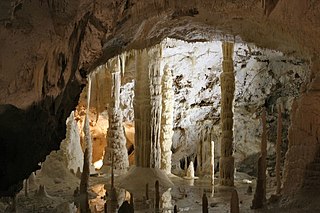 W
WThe Frasassi Caves are a karst cave system in the municipality of Genga, Italy, in the province of Ancona, Marche. They are among the most famous show caves in Italy.
 W
WFurong Cave is a karst cave located on the banks of the Furong River, 20 km (12 mi) from the seat of Wulong District, Chongqing, People's Republic of China.
 W
WThe Grutas de Cacahuamilpa National Park in Guerrero, Mexico, is best known for the Grutas de Cacahuamilpa Caverns, which are one of the largest cave systems in the world. It is also home to the Grutas of Carlos Pacheco, a smaller system, as well as two subterranean rivers which have carved out tunnels in the rock. The park has outdoor pursuit attractions such as rappelling, and rock climbing in Limontitla Canyon. as well as the two underground rivers to explore. It also has a small botanical garden, a pool and places to camp.
 W
WHuanglong Cave is a karst cave located near the Wulingyuan district of Zhangjiajie City, Hunan, People's Republic of China and a national 4A rated scenic area. As of 2010, the cave has over a million visitors per year. Since 1997, the Huanglong Cave scenic area has been managed by Beijing-based China Datong Co. Ltd. It was previously managed directly by the Hunan provincial government.
 W
WJiuxiang Scenic Region is located in Jiuxiang Yi and Hui Autonomous Township of Yiliang County 90 km away from central Kunming, Yunnan Province, China.
 W
WKitley Show Cave is a solution cave in Yealmpton, Devon, England. Originally discovered by quarrying, it used to be open to the public as a show cave, but is now closed.
 W
WThe Langun-Gobingob Cave System also known as Calbiga cave is a cave system located at Calbiga within the Samar Island Natural Park. It covers an area of approximately 2,968 hectares. The cave system has 12 caves including Langun, Gobingob, Lurodpon and Bitong Mahangin.
 W
WThe Macaque Cave is a karst cave located on the Macaque Ridge (猕猴岭) outside Dongfang City, Hainan, People's Republic of China.
 W
WMarinova dolostone quarry is a quarry in a mineral deposit situated on a dolostone deposit of Pskov formation with a thickness of about ten metres in Võru County, Meremäe rural municipality in Estonia. Marinova quarry is mining and crushing construction dolomite.
 W
WNewsome Sinks Karst Area is a privately owned karst formation in Morgan County, Alabama. It was listed as a National Natural Landmark in November 1973.
 W
WOjo Guareña is a karst complex located in the Cantabrian Mountains of Castile and Leon, Spain, declared a natural monument by the government of Castile and Leon in 1996. It is composed of over 90 kilometres (56 mi) of galleries and passages within an area of some 13,850 hectares. The limestone formation containing the system is approximately 100 metres (330 ft) thick and sits on a massive water-resistant layer of marl. The caves were formed in the limestone by erosion sometime within the Coniacian Age. Ojo Guareña was considered the greatest karst system of the Iberian Peninsula until 2009, when a significant length of new passages was discovered in the Mortillano system.
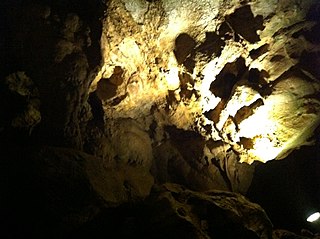 W
WThe Pastena Caves are a karst cave system located in the municipality of Pastena, in the province of Frosinone, Lazio.
 W
WThe Pertosa Caves, co-officially named Pertosa-Auletta Caves since 2012, are a karst show cave system located in the municipality of Pertosa, in the province of Salerno, Campania, Italy.
 W
WA pit cave, shaft cave or vertical cave—or often simply called a pit or pot ; jama in South Slavic languages scientific and colloquial vocabulary —is a type of cave which contains one or more significant vertical shafts rather than being predominantly a conventional horizontal cave passage. Pit caves typically form in limestone as a result of long-term erosion by water. They can be open to the surface or found deep within horizontal caves. Among cavers, a pit is a vertical drop of any depth that cannot be negotiated safely without the use of ropes or ladders.
 W
WPınargözü Cave, is a cave 18 kilometres (11 mi) west of the town of Yenişarbademli in Isparta Province, Turkey. It is considered the longest cave in Turkey, although it has not yet been fully explored, and the precise extent to which it has been explored is in dispute.
 W
WShort Drop Cave and Gavel Pot are different entrances into the same cave system on Leck Fell, in Lancashire, England. The main top entrance, Short Drop Cave, is a small hole in a fenced off shakehole near the main stream sink; Gavel Pot, a window into the system, is a large fenced shakehole some 40-metre (130 ft) deep requiring tackle to descend. There are two other smaller entrances into Short Drop Cave. At its base the system links via a sump with Lost Johns' Cave, and is part of the Three Counties System, an 87 kilometres (54 mi) cave system which spans the borders of Cumbria, Lancashire, and North Yorkshire.
 W
WSnowy Jade Cave is a National Three Gorges Scenic Area and a National 4A Scenic Area located in Fengdu County, Chongqing Municipality, People's Republic of China, not far from the Yangtze River.
 W
WThe Sohoton Caves and Natural Bridge Park is a protected natural area about 841 hectares and a tourist attraction within the Samar Island Natural Park. The natural park features caves, subterranean rivers, waterfalls, limestone formations, thick forest and a natural stone bridge. It is just a small portion of the Samar Island National Park covering the 3 provinces namely Northern Samar, Eastern Samar and Samar. The entire area is 455,700 hectares, home of the various wildlife, rivers and cave connections. It is located at Brgy. Guirang, Basey and has an area of approximately 840-hectares. First established as the Sohoton Natural Bridge National Park in 1935, it was then renamed as the Sohoton Cave Natural Park, and finally to the Sohoton Cave and Natural Bridge.
 W
WTaiji Cave is a karst cave located on Shilong Mountain (石龙山) in Guangde County, Xuancheng City, Anhui Province, People's Republic of China, where the provinces of Jiangsu, Zhejiang and Anhui meet. Ming Dynasty writer and poet Feng Menglong described the cave as one of the "Four Absolutes Under Heaven". It is also considered a primary "Place of Enlightenment" by Taoists, similar to the Bodhimanda of Buddhism. The 200-million-year-old cave is divided into dry and wet layers representing the yin and yang of Chinese philosophy. In February 2004, the Chinese State Council included the cave on its fifth list of National Scenic Attractions. It is also a 4A rated National Tourism Area.
 W
WThe Three Counties System is a set of inter-connected limestone solutional cave systems spanning the borders of Cumbria, Lancashire and North Yorkshire in the north of England. The possibility of connecting a number of discrete cave systems in the area to create a single super-system that spans the county borders was first proposed by Dave Brook in 1968, and it was achieved in 2011. The system is currently over 86 kilometres (53 mi) long, making it the longest in the UK and the twenty-seventh longest in the world, and there continues to be scope for considerably extending the system.
 W
WThe Toirano Caves are a karst cave system in the municipality of Toirano, in the province of Savona, Liguria, Italy.
 W
WTrou de l’Abîme also known as La caverne de l'Abîme and Couvin Cave is a karst cave located on the right bank of the Eau Noire river in the center of Couvin, Belgium, in Namur province. During various archaeological excavations of sediment deposits Mousterian artefacts and a Neanderthal molar were discovered.
 W
WVrtiglavica, also Vrtoglavica, is a karst shaft on the Kanin Plateau, part of the Kanin Mountains, Western Julian Alps, on the Slovene side of the border between Slovenia and Italy. It has the deepest single vertical drop in the world, at 603 metres (1,978 ft). The cave formed in a glaciokarst landscape; that is, a karst landscape that was subjected to Pleistocene glacial activity.
 W
WThe Wells Gray Park Cave discovery of 2018 was of a karst cave in Wells Gray Provincial Park, in the Cariboo Mountains in British Columbia, Canada. The cave has informally been named Sarlacc's Pit pending an official name.
 W
WWild Lake is a lake near Idrija in western Slovenia and a karst spring of the Vauclusian type. The lake is the source of the Jezernica River, a tributary of the Idrijca and, at 55 metres (180 ft) long, the shortest river in Slovenia. Water flows from under the ground and through a steeply inclined tunnel, explored to a depth of 160 metres (520 ft). The discharge occasionally surpasses 60 cubic metres per second (2,100 cu ft/s). However, when the water level is low, there is no outflow from the lake. In 1967, the lake was protected as a natural monument. In 1972, it was arranged to be the first Slovenian natural museum.
 W
WThe Wimsener Höhle is Germany´s only water cave, which can be visited by boat. It is located in the municipal area of Hayingen on the Swabian Alb, about three kilometers north of Zwiefalten.
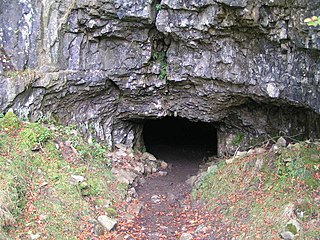 W
WYordas Cave is a solutional cave in Kingsdale, North Yorkshire, England. It has been renowned since the eighteenth century as a natural curiosity, and was a show cave during the nineteenth century. It is now a popular destination for cavers, walkers, and outdoor activity groups.
 W
WZhijin Cave is a karst cave located in Minzhai Village (民寨乡), Zhijin County, Guizhou Province, People's Republic of China. An important tourism area, the site lies 23 km (14 mi) northeast of the county town and 166 km (103 mi) from the provincial capital, Guiyang.